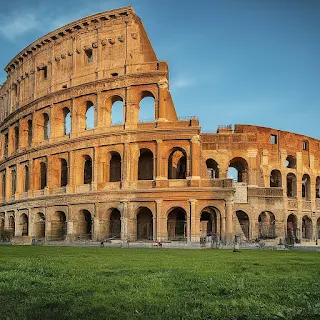In the heart of Rome, the Colosseum stands as a monumental testament to the architectural brilliance and cultural grandeur of ancient Rome. Known for its colossal size, iconic design, and historical significance, the Colosseum remains one of the most visited and admired landmarks in the world. This article delves into the rich history, architectural marvels, and enduring legacy of the Colosseum, exploring why it continues to captivate the imaginations of people across the globe.
Historical Background
The Colosseum, originally known as the Flavian Amphitheater, was commissioned by Emperor Vespasian of the Flavian dynasty around 70-72 AD. Construction was completed in 80 AD under his son, Emperor Titus, and later modifications were made during the reign of Domitian, Titus's younger brother. The Colosseum was built on the site of Nero's Golden House, a vast palace complex, symbolizing the return of land to the Roman people and the end of Nero's extravagant rule.
The Colosseum was designed to host a variety of public spectacles, including gladiatorial contests, animal hunts, mock naval battles, and theatrical performances. These events were central to Roman social and political life, serving as a means of entertaining the masses, demonstrating imperial power, and reinforcing social hierarchies. The amphitheater could accommodate an estimated 50,000 to 80,000 spectators, making it one of the largest and most impressive structures of its time.
Architectural Marvel
The Colosseum's architecture is a masterpiece of ancient engineering and design. The elliptical structure measures approximately 189 meters (620 feet) long, 156 meters (512 feet) wide, and stands about 48 meters (157 feet) tall. Its exterior consists of three tiers of arches, each adorned with columns of the Doric, Ionic, and Corinthian orders, reflecting the architectural sophistication of the period.
The Colosseum's innovative design includes a complex system of vaults and arches, which provided both strength and flexibility to support the massive structure. The use of concrete and travertine stone allowed for the construction of large, open spaces without the need for extensive interior supports. This engineering prowess enabled the Colosseum to withstand the test of time and remain largely intact despite centuries of natural disasters, neglect, and repurposing.
One of the most remarkable features of the Colosseum is its underground hypogeum, a network of tunnels and chambers beneath the arena floor. The hypogeum housed gladiators, animals, and stage machinery, allowing for the dramatic and seamless execution of events. Trapdoors and elevators enabled quick changes of scenery and the surprise appearance of combatants, adding to the excitement and spectacle of the games.
Cultural Significance
The Colosseum's cultural significance extends beyond its architectural achievements. As the epicenter of Roman entertainment, it played a crucial role in the social and political fabric of ancient Rome. Gladiatorial contests, in particular, were a reflection of Roman values such as bravery, endurance, and martial skill. These events were often sponsored by emperors and wealthy elites as a means of gaining favor with the populace and showcasing their generosity and power.
The games held at the Colosseum were not merely spectacles of violence; they were also imbued with religious and ceremonial importance. Many events were dedicated to the gods, and the arena itself was considered a sacred space. The Colosseum's role in Roman society was multifaceted, serving as a venue for public gatherings, a tool for political propaganda, and a stage for the enactment of cultural and religious rituals.
Decline and Rediscovery
The Colosseum's use as an entertainment venue declined by the 6th century AD as the Roman Empire faced internal strife and external threats. Over the centuries, the amphitheater suffered from natural disasters such as earthquakes, which caused significant damage to its structure. It was also repurposed for various uses, including as a fortress, a quarry for building materials, and a Christian shrine.
Despite its decline, the Colosseum remained an iconic symbol of Rome's imperial past. Its rediscovery and subsequent restoration efforts in the 18th and 19th centuries reignited interest in the monument. Archaeologists, historians, and architects worked to preserve and study the Colosseum, uncovering its history and ensuring its legacy for future generations.
Modern-Day Legacy
Today, the Colosseum stands as a powerful symbol of ancient Rome's grandeur and cultural heritage. It attracts millions of visitors annually, who come to marvel at its architectural splendor and learn about its rich history. The Colosseum is also a UNESCO World Heritage Site and one of the New Seven Wonders of the World, underscoring its global significance and universal appeal.
Efforts to preserve and protect the Colosseum continue to this day. Conservation initiatives focus on addressing the challenges posed by pollution, weathering, and the impact of tourism. Modern technology and research methods are employed to ensure the structural integrity of the monument and to enhance the visitor experience through educational programs and interactive exhibits.
The Colosseum also serves as a venue for contemporary cultural events and performances, bridging the gap between ancient and modern Rome. Its enduring presence in popular culture, literature, and film highlights its lasting impact on the collective imagination and its role as a symbol of human achievement and resilience.
Quick Knowledge about The Colosseum
The Colosseum stands as a testament to the architectural brilliance, cultural vibrancy, and enduring legacy of ancient Rome. As one of the most iconic landmarks in the world, it continues to inspire awe and admiration in all who visit. The Colosseum's rich history, remarkable architecture, and cultural significance ensure that it remains a symbol of Rome's majestic past and a beacon of human ingenuity. As we gaze upon its towering arches and walk through its storied halls, we are reminded of the timeless allure of this magnificent amphitheater and its place in the annals of history.

